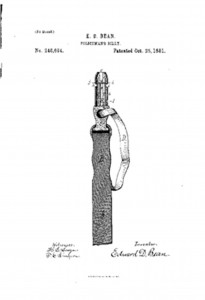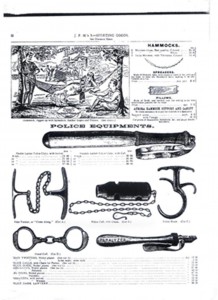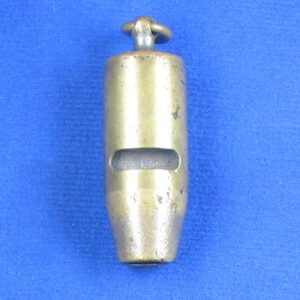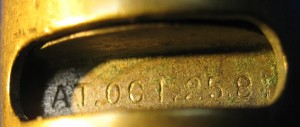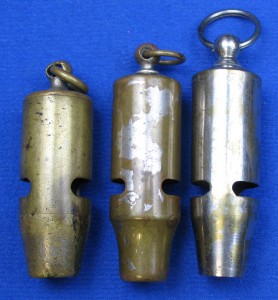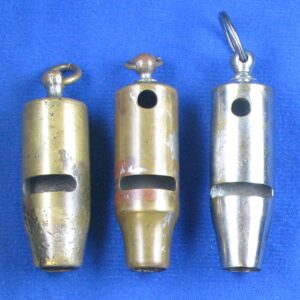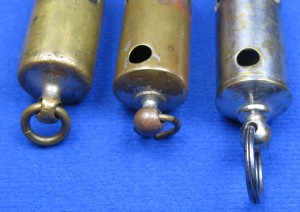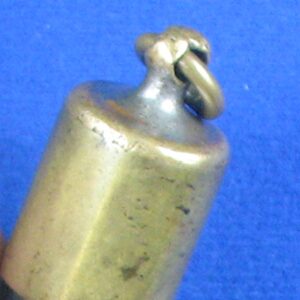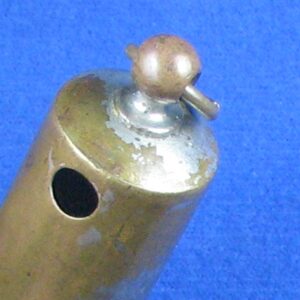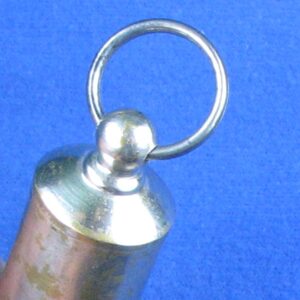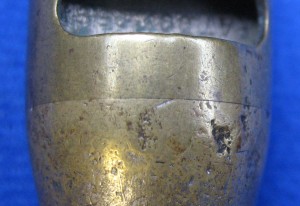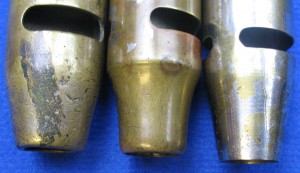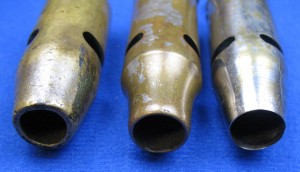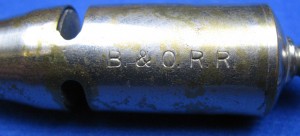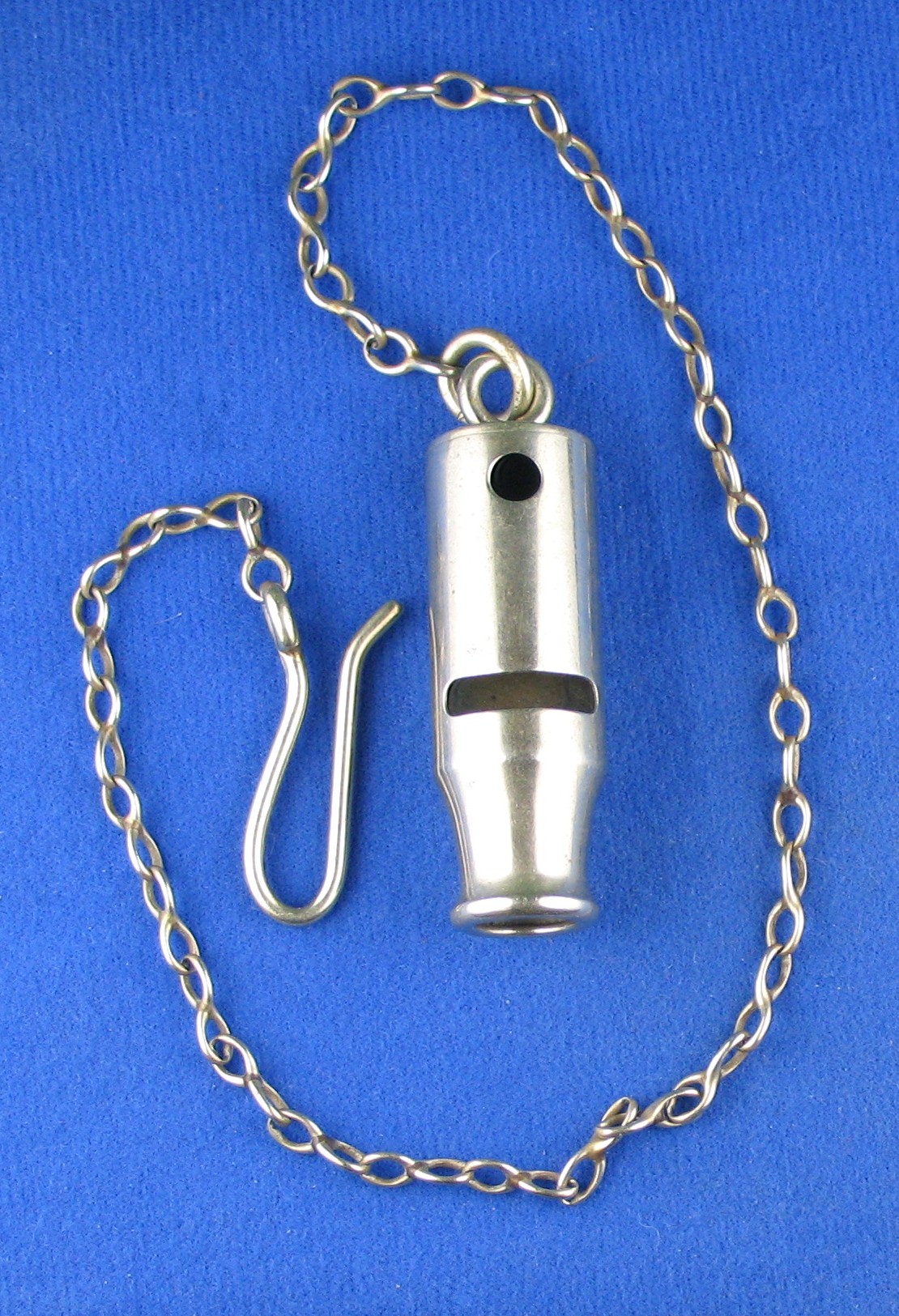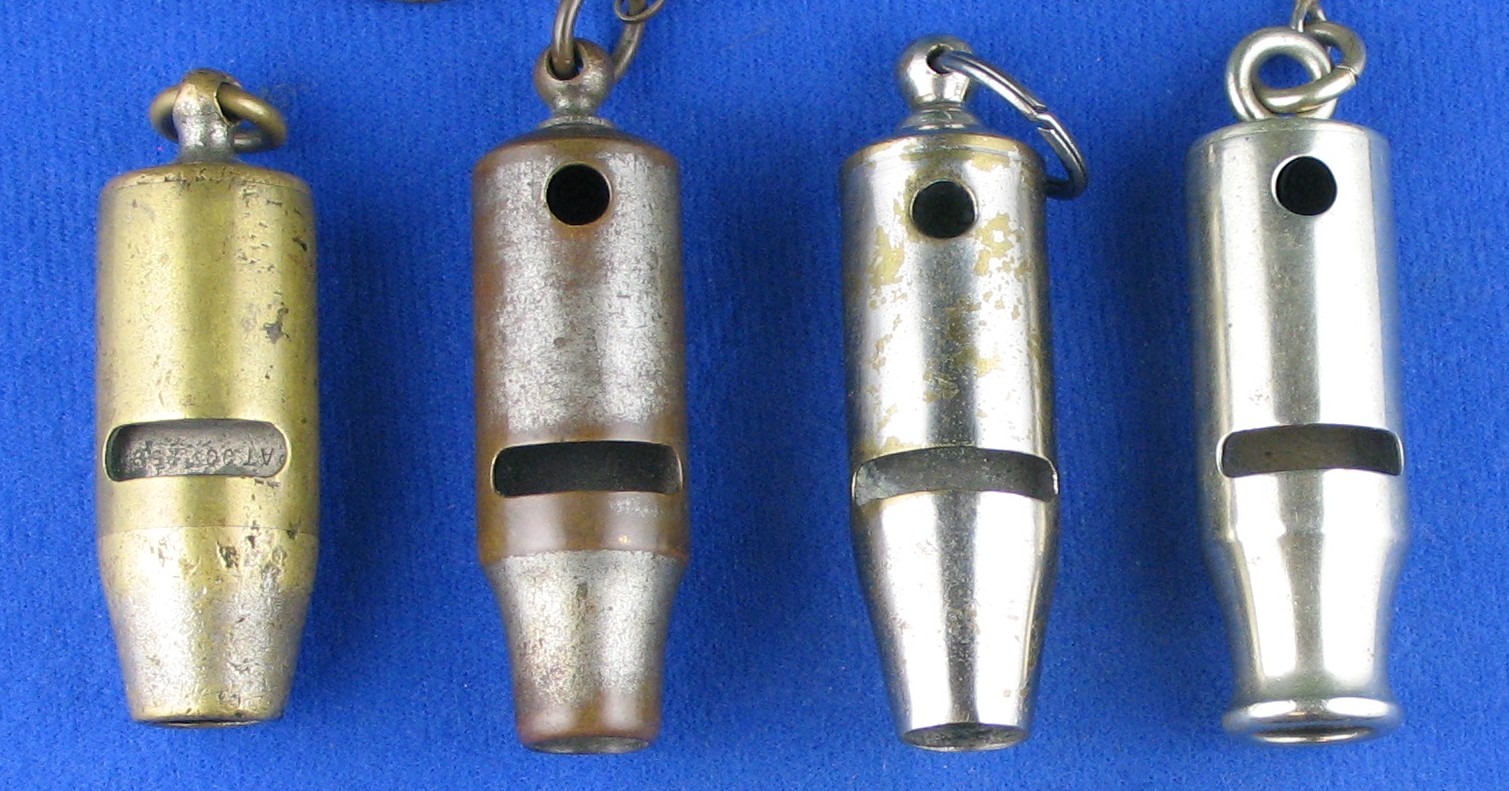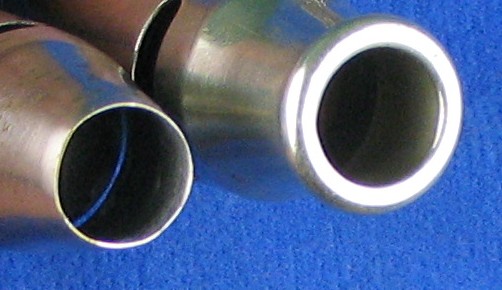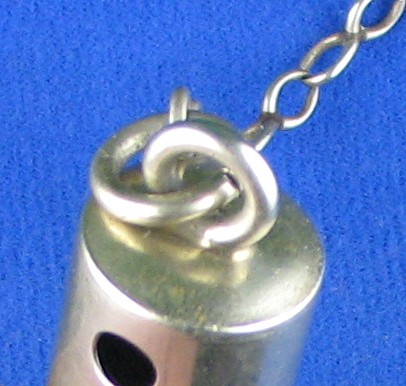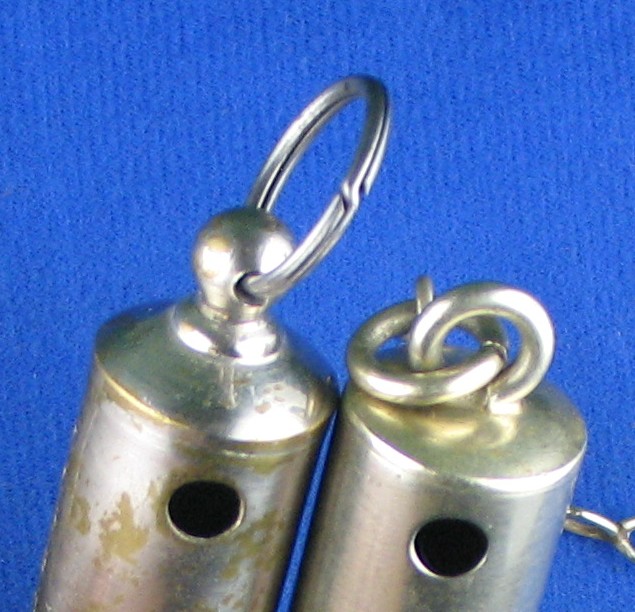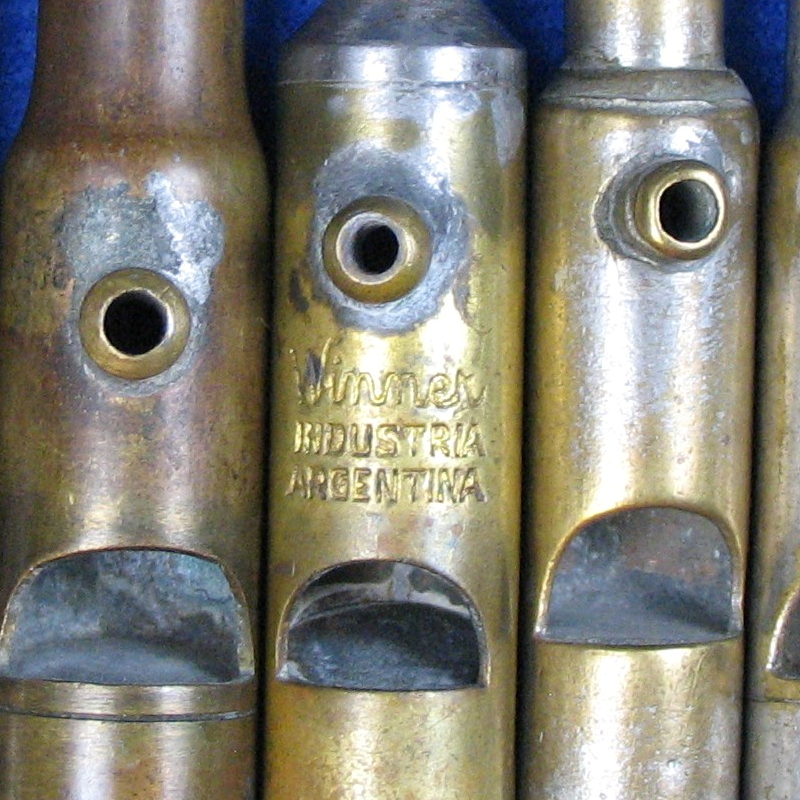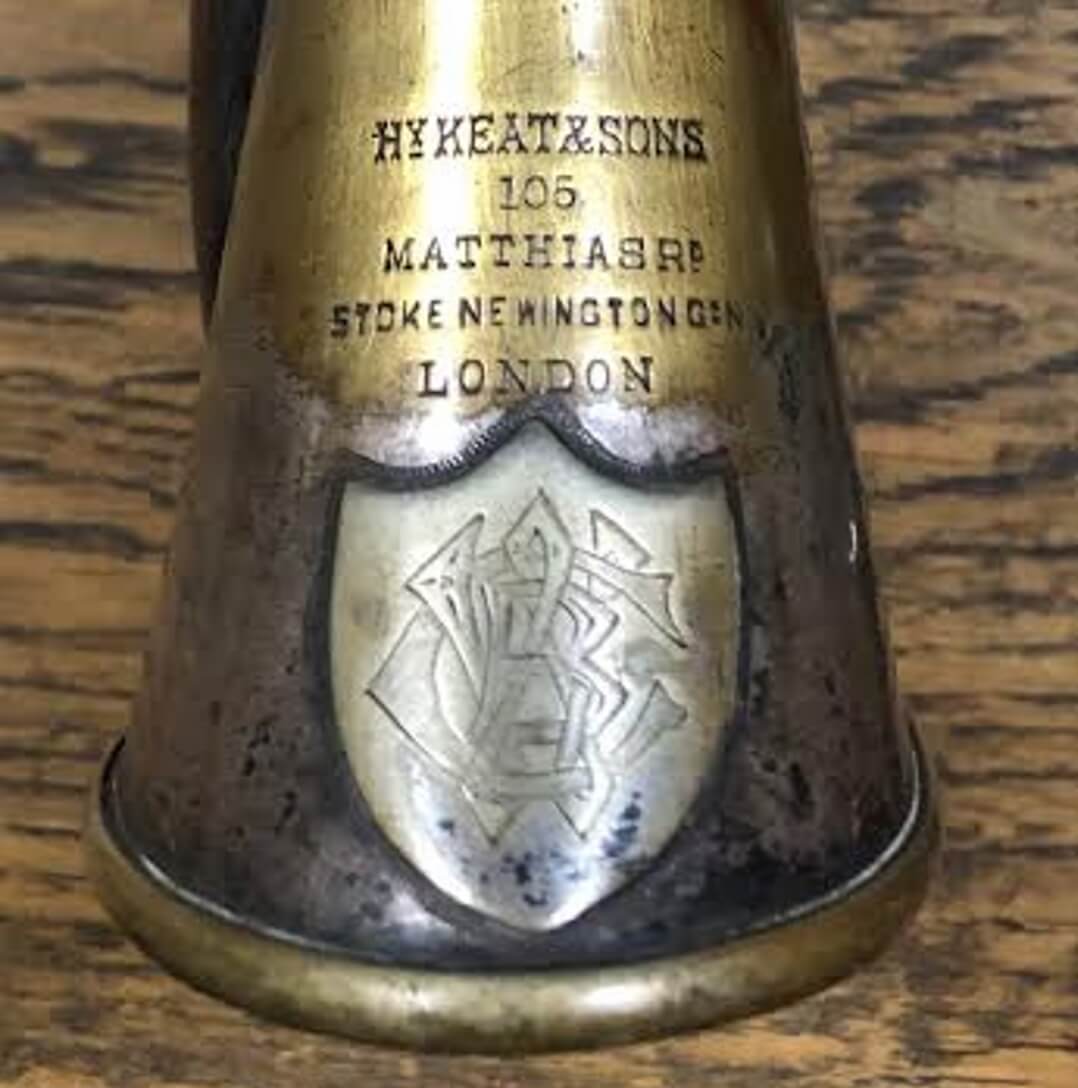Spotlight > Whistle Categories > Police > 043
The SPOTLIGHT for E.D. Bean’s police whistle is rather complicated. The complexity lies between inventing and manufacturing. Usually the manufacturer is the designer, with exceptions ( i.e. Porteous, Lilly, etc.). In the case of Edward Bean he did not manufacture his police equipment. Who did then ?? That remains the question to date. Perhaps some connections can be made though.
Edward Davis Bean was born in the USA July 29, 1838 in Hollis, Maine and died December 12, 1908 at 70 years of age as a ‘retired inventor’.
He is known primarily for his handcuffs and for a variety of police equipment. Our focus however is on whistles of which he invented only one. He invented the one whistle and had it patented. At first it is found as being a permanent attachment to a Billy club ( downloaded courtesy of Google Patent search ) October 25, 1881. Later by 1886 he would be marketing his whistle individually.
The descriptive design notes of his patent are described in 1881 and were submitted April 6 1881 , apparently even before Joseph Hudson in the UK claimed to discover that varying the chambers and using a partition could create a distinctive dissonance that would be clearly recognizable for the police. Hudson was already producing a double note whistle ( without varied chambers ) prior to his historic 1883 contract with the Metropolitan Police Force that did utilize varied dissonant chambers. For how long he was manufacturing whistles prior to 1883 is not known. Bean’s description is as follows:
To vary the note of the whistle one chamber ( by changing the depth ) is of considerably less than the other, and at the bottom of the opposite chamber, g, I create an opening, I. By closing the opening Z and leaving the openings h *5 open one tone is produced. By closing the openings h and 1 another note is produced. By leaving the three openings h H open still another note is produced. By alternately opening and closing the hole l a trill is produced.
When examined closely it can be seen that truly one chamber is indeed ‘considerably less capacity than the other’ In his earlier model there is no stop hole for signaling.
Unraveling who possibly manufactured it proves more revealing. The parties involved follows:
John J. Tower- manufacturer/hardware 1865
Polhemus Lyon- partner
Union Hardware – manufacturer/distributor 1864 Wolcottville ( renamed Torrington 1880 ), Connecticut
( 1898 John J.Tower was already on the board of directors ) Interestingly, Marcellus Hartley started and owned BGI from 1878 on, which manufactured a large list of whistles turn of the 19th century. BGI never advertised Bean whistles, although they did advertise F.L. Johnson whistles.
Johnson Bye and Co – 1871
Iver Johnson – manufacturer/distributor – 1883
Iver Johnson arms and cycle works ( Mass. ) – 1891 ( Mossberg worked in the cycle factory, then left )
John P. Lovell Arms – manufacturers/distributor ( sold to Johnson 1900, Iver died 1895, taken over by his son )
Conclusions??
Tower was selling whistles as early as 1880. Tower selling Lovell wares 1887 & Bean equipment by 1893
although Bean and Tower had been competitors in the 1880s.
Lovell sold Tower police equipment 1887.
Clearly there was a working relationship that existed between Lovell and Tower and Johnson. Add to this that…
E.D Bean did not actually manufacture any of his own inventions…
Forte suggests that Lovell actually manufactured Bean's handcuffs — therefore his whistle was likely produced by them and would be the follow up conclusion. This would lead to Tower producing his whistles after that since he took over Lovell. The earliest whistles were very costly and high quality. Later they dropped noticeably in quality. We should expect to see a change in production methods leaning towards a cheaper manufacturing method over such a period.
Forte reports handcuffs patented by Bean November 28, 1882. Apparently clones were ‘invented’ November 18, 1884 by Johnson that had only a minor adjustment out of patent. In fact a clone of Johnson’s has Beans 1882 patent stamp on it — further showing Johnson manufacturing of Bean’s cuffs.
In 1881 Bean whistles were selling for one dollar. That is calculated in 2014 inflationary adjustments to be $23.26. Quite a bit for a whistle. All advertising stated that his whistles were to be sold to the police departments only. No public sales. This has contributed to the scarcity of them today.
William Frankfurth Hardware advertised the Bean whistle still in 1918.
With the forgoing in mind let’s now look closely at the start and progression of the Bean whistle…
Inside the patent date can be seen stamped on the partition. Take a closer look at both.
Next, what you can’t see. The partition is off center creating two different size chambers as described in the inventor’s patent application, thus creating dissonance.
Over the years the whistle grew in size as models were adjusted for production.
In the next picture both stop holes can be seen. None was provided for the oldest model.
Side by side the ‘growth’ is apparent. In fact the lighter construction is also noted. The second has a concave mouthpiece and the third is merely tapered. The 2nd and 3rd also have applied knops onto the top caps.
Interestingly the 3rd was so thinly made that there is an impact crack in the mouthpiece. And diverging from its original path is the stamp B & O RR – a railway stamp.
From this close up several things are seen. For one, the top cap is attached as one cast piece ( i.e. knop and cap. Is there a body seam ?? Can’t tell. The body is very thick though and could be one solid piece drilled out.
Then there is also the seam where the mouthpiece meets the body. This would be eliminated on later models. The mouthpiece is also cast. This would have been an expensive whistle to manufacture.
Is the stop hole of his 1881 patent the earliest appearance of a stop hole ??
Very few whistles in the USA were stamped for railways, B&O being an exception.
Are there any conclusion s to be drawn about the Bean police whistle ??
Perhaps, still some mysteries surround its invention and manufacturing. It appears that Lovell did manufacture it and that Johnson took over. It was manufactured ( or at least sold ) for 40 years. A very expensive whistle to manufacture at first, it was aimed at the police equipment market and then later and with less quality, to the public and railway and eventually for cycling ( see below )
There were at least four models over the years. However at first there was an application to Billy clubs. Thereafter moving towards independent use ( and employing stop holes — perhaps the earliest known use. If not, it would have been Yates in the UK — probably with railway rounds ). Finally they changed from a very heavy and well-made whistle, to a lighter and less expensive model.
The timing of E.D. Bean’s 1881 patented police whistle, compared to Hudson’s 1882 Manchester Police model ( Gilchrist p.6 CPWs) — suggests that it may have been a year before Joseph Hudson’s historic Metropolitan Police whistle. This would mean that Bean first successfully employed a different method of creating dissonance (i.e. a double note) in a police whistle.
He accomplished this by his own method, not a small reduction in the length of the chambers ( Gilchrist p.5 CPWs ) as Hudson did. Bean moved the partition over — creating two sizes of chambers, one larger than the other creating two notes.
Some terrific insights have come to light with this close up study of E.D. Bean’s whistles from the USA. It takes years of patience and diligence and of course it takes the whistles themselves. Perhaps even more will come to light about this previously enigmatic whistle and its inventor Edward D. Bean. — ( see below for addendum. )
TWG
Posted March 20, 2015
Addendum: Posted January 2, 2017
Here is a late addtion of a previously unseen Bean model complete with the original chain and hook.
Arranged for a comparison reveals that the last model compares in size to previous models.
The mouthpiece is now rolled and the construction is made through a unibody pressing.
Notice also a top ring instead of a round knop and how it compares.
TWG
